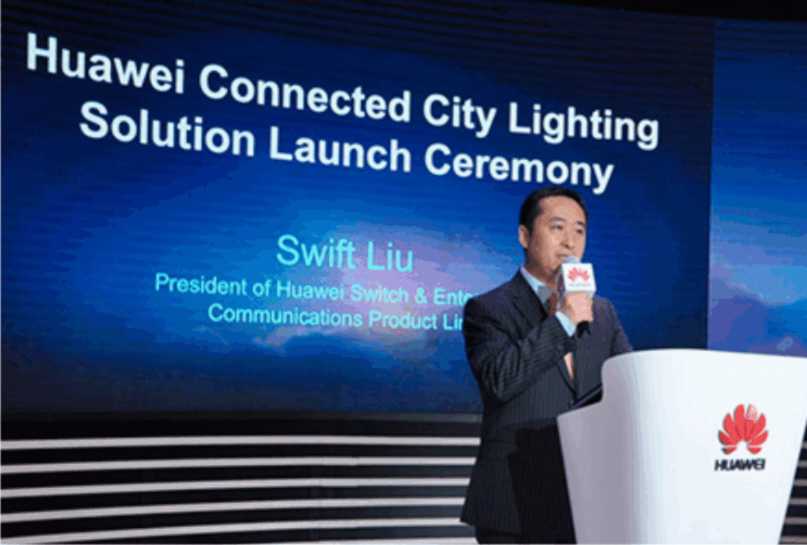Huawei took its ‘building a better connected world’ payoff a notch further at the just concluded CeBIT 2016 in Hannover, Germany, by unveiling what could be a key solution to Next-Generation safe cities, the Matrix Intelligence Solution, described as the “industry’s first Internet of Things (Io) lighting solution with multi-level intelligent control.
Huawei, which is the world’s largest telecommunications equipment manufacturer, says with the explosive growth of global Safe City video data, the traditional Safe City architecture fails to effectively utilise massive amounts of data and meet customer requirements for timeliness.
Consequently, “Huawei introduces Big Data analytics and intelligent cloud technologies into video surveillance services to explore value from data, helping customers address the preceding challenge.
“Depending on business needs, Huawei’s “Matrix Intelligence” solution automatically schedules all available computing resources within Safe City systems to perform distributed intelligent analysis and computing without occupying unnecessary bandwidth, storage, or computing resources. By doing so, the solution improves intelligent analysis efficiency by a factor of 10 and helps government agencies build more efficient and intelligent Safe Cities.”
According Huawei, its Connected City Lighting Solution “connects street lamps to the IoT and adopts a GIS-based management system, enabling cities to enhance the control and performance of every street lamp. The solution provides municipal managers with status information on each lamp, in every street and enables precise control of on-off switches and brightness of individual street lamps, allowing on-demand lighting and a reduction in energy consumption by up to 80%.
The Climate Group says there are approximately 304 million street lamps around the world, and the number is expected to reach 352 million by 2025. Street lamps are almost ubiquitous in cities.
While these lamps bring convenience to people’s lives, they also consume a vast amount of energy and increase management costs for municipalities. For example, London has approximately 35,000 street lamps, resulting in an estimated total power consumption of 56,000,000kWh per annual, together with inspection costs and maintenance fees, the street lamps significantly impact municipal expenses.
Thus, the Huawei Connected City Lighting Solution is designed to address these issues.
With Huawei’s Connected City Lighting Solution, each street lamp is equipped with a power and brightness controller. Unlike industry-standard access methods such as through Wi-Fi, Huawei adopts 6LoWPAN technology, which has lower power consumption, and can automatically diagnose, network, and trouble-shoot problems, as well as enable better interaction between street lamps and other smart devices such as sensors.
To enhance the control and performance of street lamps, the solution integrates a series of preset smart lighting policies to:
- Automatically calculate lighting duration based on local longitude and latitude, and dynamically adjust lighting duration according to the specific season, month, and day.
- Smartly adjust brightness by connecting built-in brightness sensors with third-party traffic and people flow sensors, or based on weather and other environment conditions.
- Automatically reduce street lamp brightness or only switch on every other lamp at midnight when traffic volume is low; or turn lamps on when there is poor visibility such as on rainy days.
Huawei Connected City Lighting Solution pares LED lamps with smart lighting polices. When compared with conventional street lamps, such as high pressure sodium lamps, they help reduce energy consumption by up to 80%.
The solution adopts a GIS-based management system, which displays comprehensive information about the street lamps, including the number of lamps in each street, their current status, as well as their installation position and time. Using this solution, one person can manage thousands of lamps in different streets. When a street lamp malfunctions, the system is automatically alerted and sends a message to notify maintenance personnel. Additionally, the solution provides full lifecycle management to prevent potential malfunctions. This reduces the need for on-site inspection, cutting manpower costs while improving management efficiency.
Multi-level Smart Control for Enhanced Protection and Reliability
Whereas traditional street lamps are controlled collectively at a central point, and cannot be controlled individually, and a system failure in this scenario could result in massive energy wastage, such as street lamps being turned on during bright sunlight, the Huawei Connected City Lighting Solution addresses this challenge by providing multi-level smart controls, which comprise network smart controls on the first level and local smart controls on a secondary level.
The agile IoT gateways and street lamp controllers are equipped with lightweight components to execute lighting policies and deliver a two-level localised decision-making mechanism. When the uplink network of agile gateways fails, local control protocols are enforced. Therefore, if the 6LoWPAN sensor network fails, street lamp controllers can work offline and function independently. Multi-level smart control minimises the lamps’ dependency of centralized controls, thereby increasing flexibility and reliability.
All-layer Openness to Build a Smart City
Huawei Connected City Lighting Solution adopts an all-layer open architecture:
- Its base-layer processor development can be based on lightweight open-source LiteOS, facilitating standardisation and efficient connections among third-party devices.
- The agile gateways support a virtualised architecture, enabling the development and installation of customised applications by partner companies.
- The agile controllers also provide third-party application systems with a standard northbound interface, helping to better integrate various service components, allowing comprehensive interaction with the smart transportation, environment monitoring, and municipal management systems.

